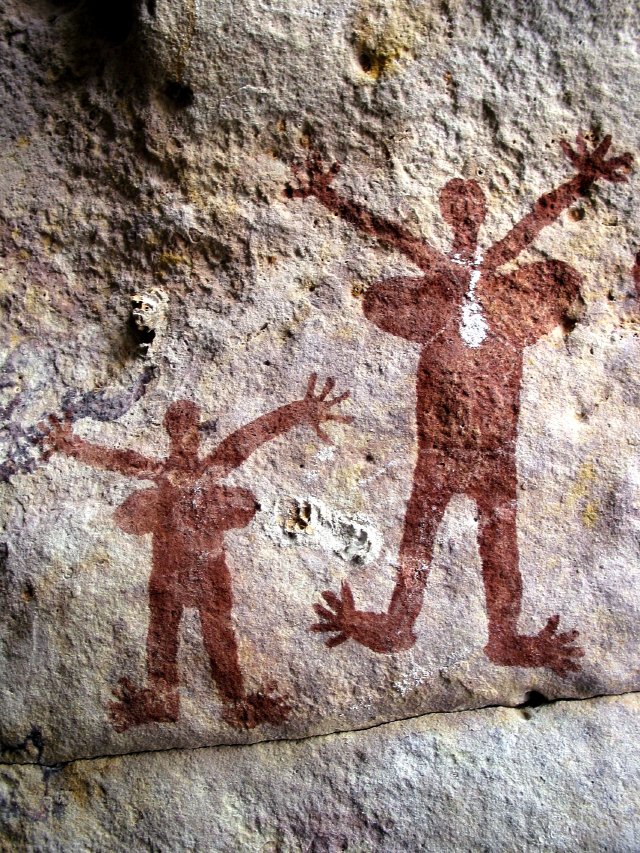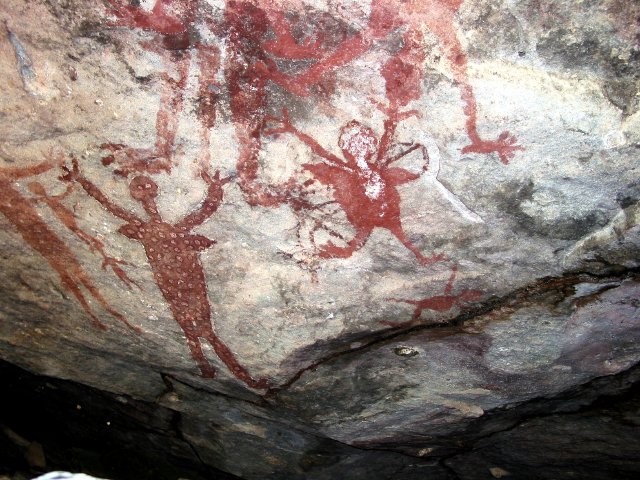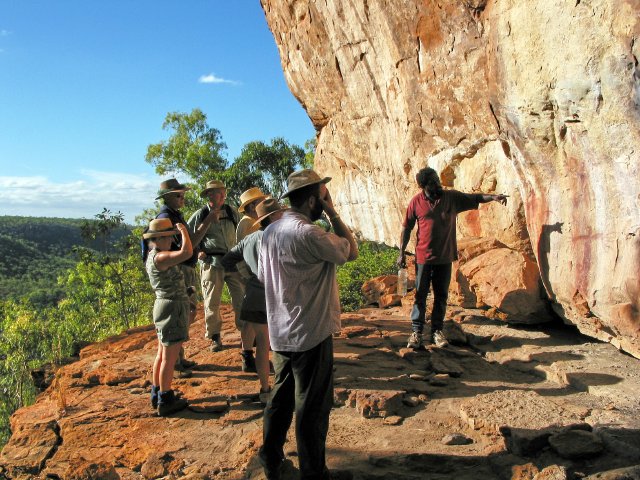Today we stayed around Jowalbinna, visiting several Aboriginal rock art galleries painted in the Quikan style.
Waking up with the kookaburras, we ate breakfast, then headed out with Sam, who runs the station. Sam certainly looks and sounds like the genuine Aussie Outback article, with Wranglers and boots and a big felt hat, and a broad-as-Australia accent that you just don't hear in the cities. I liked him--he knew what he was talking about, showed us a bit about the countryside as well, and introduced us to some of the plants used for bush tucker around the station. He showed us that the flowering stalk of a grass tree is sweet if you run your finger along it, and that you can eat green ants if you pinch the head between your fingers and nibble off their bottom green ends. I couldn't get an ant to hold still to let me catch it, but Chris said they tasted citrusy.
The first gallery we went to was the Wallaroo Dreaming gallery, dominated by a large Wallaroo (a kangaroo like creature), and several other figures. Sam interpreted some of the paintings for us: a solid white painting of something like an eel or a dingo is the person's totem, if they're standing upright they are generally good, if they're on their side they're sick (or being made sick through the drawing), if they're upside down they are wished dead. He also mentioned really good way of figuring out what animal it is: look at the feet in the painting. Since Aborigines were very keen trackers, they generally keep the feet shaped like the animal's footprint.
After that gallery, we went to Snake Dreaming, which was in a bit less preserved state, then back for lunch.
After lunch, a local Aboriginal guy named Roy took us up another canyon, with many more sites than the morning tour. The first site was a clan site for the Death Adder clan, marked with three stacked crescents pointing up. Roy's father had explained what all the other symbols meant at this one small site: one section denoted a wedding, with the bride wearing a headdress, and many people celebrating after the wedding. There were also other images of eels and freshwater catfish and fruit bats, as well as the yam that was a staple food.
We climbed up the hill to some other sites as well. The Honeymoon Cave is a low ceiling cave with many paintings of sex and fertility on it--it certainly would make a great honeymoon suite, as it's just large enough to fit a couple of sleeping bags in it and sit up without banging your head! At the back is a painting of a man and a woman having sex, there's a small section with a painting of a man and a woman and a sick child (on its side) that warns first cousins not to marry each other, and there are also paintings of turtles--a symbol of male fertility. Roy said that this was also a teaching cave, where boys were brought to learn about things when they became men.
There was also a love story in one of the paintings near the Honeymoon Cave: two large images of a man and a woman, with a smaller image of a woman with a pendant around her neck. The love story is simple. The man painted the image of the woman with a pendant around her neck, and sang songs hoping she would love him. She did, so he came back and painted the two larger images of himself and her, on top of the white images of their respective totem groups. I like that story.
Just up from Honeymoon Cave is a shelf just under the ridgeline with fantastic views... we stopped, then headed back down to the cars. The last cave had a large guardian figure protecting the area, and a small depiction of the good god Tanaka (in white outlined in black) battling the evil Maane (with spiky hair) over the soul of someone recently departed (I probably got the spellings wrong).
The day was interesting--we learned a bit about the plants, and about the people that lived around there up until the 1920s or so when the last paintings were made. It was different that Carnarvon Gorge--although there were a few stencils of hands, most of the work was freehand, and there were very few depictions of boomerangs or axes or other 'manly-man' items. These paintings were mostly about people and guardians and weddings... and fishing trips.

















